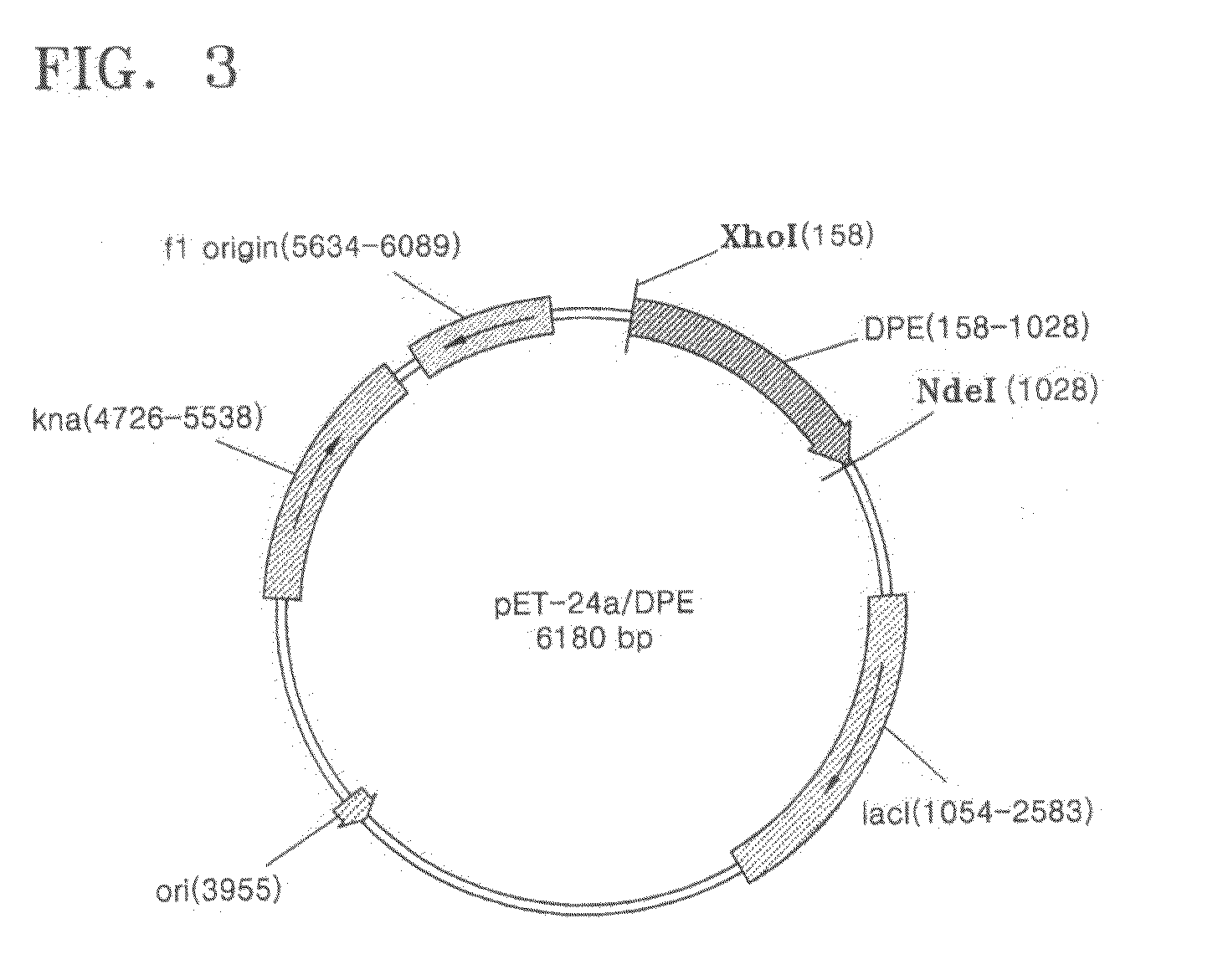D-psicose production method by d-psicose epimerase
- Summary
- Abstract
- Description
- Claims
- Application Information
AI Technical Summary
Benefits of technology
Problems solved by technology
Method used
Image
Examples
experimental example
[0037]In the current Experimental Example, MALDI-TOF-MS was used for the measurement of the molecular weight of psicose 3-epimerase, and cinnamic acid was used as a matrix. The enzyme activity was measured by using D-fructose as a substrate. For the measurement of the enzyme activity, psicose 3-epimerase was allowed to react with D-fructose in a 50 mM PIPES buffer solution containing 1.0% of D-fructose, at pH 7.5 and at 50° C. for 20 minutes, and then the reaction solution was heated at 100° C. for 5 minutes to terminate the reaction. The PIPES buffer solution containing D-fructose was prepared by dissolving D-fructose in PIPES buffer solution at pH 7 to 8 to a concentration of 60 to 70% by weight, and the PIPES buffer solution containing D-fructose was continuously added to a bioreactor maintained at 40 to 60° C. For the purpose of easy comparison of the enzyme activity, one unit of psicose 3-epimerase is defined as the amount of the psicose 3-epimerase needed to produce 1 mole of ...
example 1
Mass Production of psicose 3-epimerase
[0039]The gene of psicose 3-epimerase was obtained in a large amount by amplifying the DNA of Agrobacterium tumefaciens ATCC33970 by a polymerase chain reaction (PCR) using a primer designed based on the DNA base sequence of a gene that had been suggested as a tagatose 3-epimerase gene of Agrobacterium tumefaciens C58 but had not been functionally characterized. The obtained gene of psicose 3-epimerase was inserted in an expression vector, pET-24a(+) (Novagen, Inc.), by using restriction enzymes XhoI and NdeI to produce a recombinant expression vector pET-24a(+) / psicose 3-epimerase (See FIG. 3). This recombinant expression vector was transformed into Escherichia coli BL21(DE3) by a conventional transformation method. The transformed strain E. coli BL21(DE3) was cryogenically stored in liquefied nitrogen before being cultured for mass production.
[0040]Thereafter, an inoculum of the cryogenically stored E. coli BL21(DE3) strain was inoculated in a...
example 2
Purification of psicose 3-epimerase
[0041]In order to perform characterization of the psicose 3-epimerase, the psicose 3-epimerase was purified using an affinity HisTrap HP column, a demineralized HiPrep 16 / 60 column, and a gel filtration Sephacryl S-100 HR column.
[0042]The molecular weight of the purified psicose 3-epimerase was measured, and it was found that the psicose 3-epimerase was a monomer having a molecular weight of 32,600 Da. The amino acid sequence of the psicose 3-epimerase was confirmed to be identical to the amino acid sequence of NCBI accession number NP—535228.
PUM
| Property | Measurement | Unit |
|---|---|---|
| Temperature | aaaaa | aaaaa |
| Temperature | aaaaa | aaaaa |
| Fraction | aaaaa | aaaaa |
Abstract
Description
Claims
Application Information
 Login to View More
Login to View More - R&D
- Intellectual Property
- Life Sciences
- Materials
- Tech Scout
- Unparalleled Data Quality
- Higher Quality Content
- 60% Fewer Hallucinations
Browse by: Latest US Patents, China's latest patents, Technical Efficacy Thesaurus, Application Domain, Technology Topic, Popular Technical Reports.
© 2025 PatSnap. All rights reserved.Legal|Privacy policy|Modern Slavery Act Transparency Statement|Sitemap|About US| Contact US: help@patsnap.com


